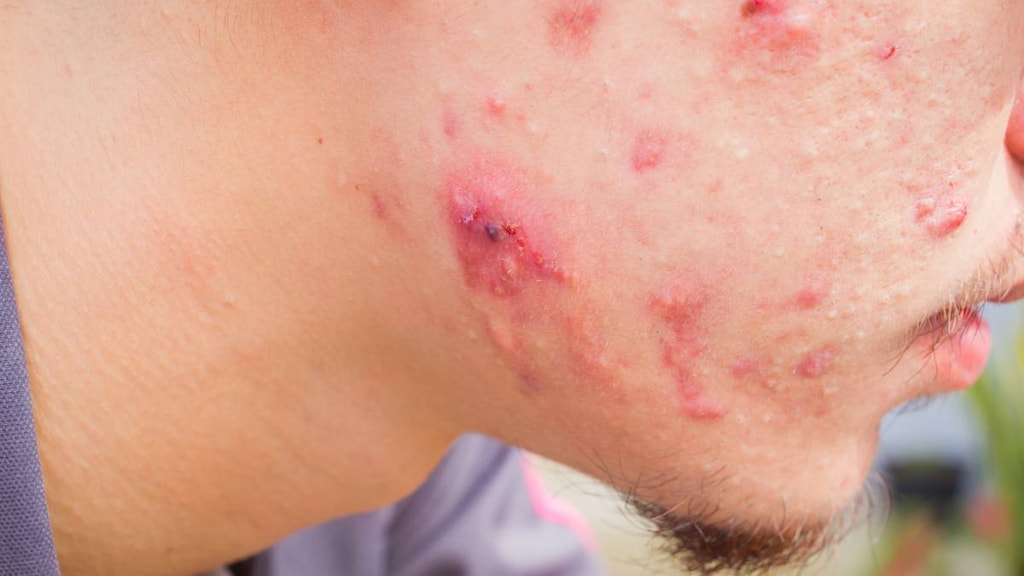Dosage Forms
Excipient information presented when available (limited, particularly for generics); consult specific product labeling. [DSC] = Discontinued product
Cleanser, topical:
AVAR: Sulfur 5% and sulfacetamide sodium 10% (227 g) [contains benzyl alcohol]
AVAR LS: Sulfur 2% and sulfacetamide sodium 10% (227 g) [contains benzyl alcohol]
Plexion: Sulfur 4.8% and sulfacetamide sodium 9.8% (285 g) [contains benzyl alcohol]
Prascion: Sulfur 5% and sulfacetamide sodium 10% (170 g [DSC])
Rosanil: Sulfur 5% and sulfacetamide sodium 10% (170 g [DSC])
Generic: Sulfur 2% and sulfacetamide sodium 10% (227 g); Sulfur 4.8% and sulfacetamide sodium 9.8% (285 g); Sulfur 5% and sulfacetamide sodium 10% (170 g, 227 g, 340 g)
Cream, topical:
AVAR-e: Sulfur 5% and sulfacetamide sodium 10% (45 g [DSC], 57 g) [contains benzyl alcohol]
AVAR-e Green: Sulfur 5% and sulfacetamide sodium 10% (45 g [DSC], 57 g) [contains benzyl alcohol; color corrective cream]
AVAR-e LS: Sulfur 2% and sulfacetamide sodium 10% (45 g [DSC], 57 g) [contains benzyl alcohol]
Clenia: Sulfur 5% and sulfacetamide sodium 10% (28 g) [DSC]
Plexion: Sulfur 4.8% and sulfacetamide sodium 9.8% (57 g) [contains benzyl alcohol]
SSS 10-5: Sulfur 5% and sulfacetamide sodium 10% (28 g)
Virti-sulf: Sulfur 5% and sulfacetamide sodium 10% (28 g) [DSC]
Generic: Sulfur 2% and sulfacetamide sodium 10% (57 g); Sulfur 4.8% and sulfacetamide sodium 9.8% (57 g); Sulfur 5% and sulfacetamide sodium 10% (28 g)
Foam, topical:
AVAR: Sulfur 5% and sulfacetamide sodium 9.5% (100 g) [contains benzyl alcohol] [DSC]
AVAR LS: Sulfur 2% and sulfacetamide sodium 10% (100 g) [contains benzyl alcohol] [DSC]
Clarifoam EF: Sulfur 5% and sulfacetamide sodium 10% (60 g [DSC], 100 g [DSC])
SSS 10-5: Sulfur 5% and sulfacetamide sodium 10% (60 g, 100 g)
Generic: Sulfur 5% and sulfacetamide sodium 10% (60 g)
Gel, topical: Sulfur 5% and sulfacetamide sodium 10% (45 g [DSC])
Lotion, topical:
Plexion: Sulfur 4.8% and sulfacetamide sodium 9.8% (57 g) [contains benzyl alcohol]
Generic: Sulfur 4.8% and sulfacetamide sodium 9.8% (57 g)
Pad, topical [cleansing cloth]:
Avar: Sulfur 5% and sulfacetamide sodium 9.5% (30s, 60s) [DSC]
Avar LS: Sulfur 2% and sulfacetamide sodium 10% (30s, 60s) [DSC]
Plexion: Sulfur 4.8% and sulfacetamide sodium 9.8% (60s) [contains benzyl alcohol]
Rosula: Sulfur 5% and sulfacetamide sodium 10% (30s [DSC], 60s [DSC])
Sumaxin: Sulfur 4% and sulfacetamide sodium 10% (60s) [contains aloe]
Generic: Sulfur 4% and sulfacetamide sodium 10% (60s)
Suspension, topical:
SulfaCleanse 8/4: Sulfur 4% and sulfacetamide sodium 8% (473 mL) [contains aloe]
Sumaxin TS: Sulfur 4% and sulfacetamide sodium 8% (473 mL) [contains aloe] [DSC]
Generic: Sulfur 4% and sulfacetamide sodium 8% (473 mL); Sulfur 5% and sulfacetamide sodium10% (30 g)
Wash, topical:
BP 10-1: Sulfur 1% and sulfacetamide sodium 10% (170 g)
BP Cleansing Wash: Sulfur 5% and sulfacetamide sodium 10% (480 mL) [contains urea]
Rosula Wash: Sulfur 4.5% and sulfacetamide sodium 10% (340.2 g [DSC])
Sulfamez Wash: Sulfur 1% and sulfacetamide sodium 10% (177 mL)
Sumaxin: Sulfur 4% and sulfacetamide sodium 9% (473 mL) [contains aloe]
Zencia: Sulfur 4% and sulfacetamide sodium 9% (480 mL [DSC]) [contains aloe]
Generic: Sulfur 4% and sulfacetamide sodium 9% (480 mL)
Wash, topical [emulsion-based]:
BP Cleansing Wash: Sulfur 4% and sulfacetamide sodium 10% (473 mL) [contains urea]
Sumadan: Sulfur 4.5% and sulfacetamide sodium 9% (454 g)
Sumadan XLT: Sulfur 4.5% and sulfacetamide sodium 9% (454 g) [packaged in a kit with Niseko sunscreen SPF 25]
Generic: Sulfur 4.5% and sulfacetamide sodium 9% (454 g)
Pharmacology
Mechanism of Action
Sulfacetamide interferes with bacterial growth by inhibiting bacterial folic acid synthesis through competitive antagonism of para-aminobenzoic acid (PABA). Sulfur is a keratolytic. Used in combination to inhibit the growth of acne-causing bacteria.
Pharmacokinetics/Pharmacodynamics
Absorption
Sulfur, topical: ~1%
Use: Labeled Indications
Acne rosacea, acne vulgaris, seborrheic dermatitis: Treatment of acne vulgaris, acne rosacea, and seborrheic dermatitis.
Contraindications
Hypersensitivity to sulfur, sulfonamides, or any component of the formulation; renal disease
Note: Although the FDA-approved product labeling states this medication is contraindicated with other sulfonamide-containing drug classes, the scientific basis of this statement has been challenged. See "Warnings/Precautions" for more detail.
Dosage and Administration
Dosing: Adult
Acne vulgaris, acne rosacea, seborrheic dermatitis:
Cream, gel, lotion, suspension, emollient cream: Apply a thin film to affected area 1 to 3 times daily.
Cleanser, cleansing cloth/pads: Wash affected area 1 to 2 times daily.
Emollient foam: Apply to affected area 1 to 3 times daily; foam may remain on skin or may be rinsed off after 1 to 10 minutes.
Dosing: Geriatric
Refer to adult dosing.
Dosing: Pediatric
Children ≥12 years and Adolescents: Refer to adult dosing.
Administration
For external use only. Wash hands prior to use. Avoid contact with eyes, eyelids, lips, and mucous membranes.
Cleanser: Apply to wet skin and massage gently into skin working into full lather for 10 to 20 seconds; rinse skin completely and pat dry skin.
Cleansing cloths/cleansing pads: Moisten skin and cloth/pad with water, work cloth/pad into lather, and massage into skin for 10 to 20 seconds; rinse skin completely and pat dry skin. Dispose in trash; do not flush.
Cream, lotion, gel, emollient cream: Apply to clean, dry skin; massage into skin completely.
Emollient foam: Apply to clean, dry skin. Prime can prior to initial use (refer to manufacturer’s labeling for priming instructions); shake can vigorously and tap bottom of can onto palm of other hand or a hard surface at least 3 times prior to each use. Foam may remain on skin or may be rinsed off after 1 to 10 minutes.
Suspension: Shake well prior to use. Apply to clean, dry skin; massage into skin completely.
Storage
Store at room temperature; protect from freezing and excessive heat. Some products may darken slightly on storage; efficacy or safety is not affected. A slight yellowish discoloration may occur when an excessive amount of product is used and comes in contact with white fabrics; this discoloration it is readily removed by ordinary laundering.
Foam: Contents under pressure; do not expose to heat or store at temperatures >49°C (>120°F). Store upright.
Drug Interactions
BCG (Intravesical): Antibiotics may diminish the therapeutic effect of BCG (Intravesical). Avoid combination
BCG Vaccine (Immunization): Antibiotics may diminish the therapeutic effect of BCG Vaccine (Immunization). Monitor therapy
Sodium Picosulfate: Antibiotics may diminish the therapeutic effect of Sodium Picosulfate. Management: Consider using an alternative product for bowel cleansing prior to a colonoscopy in patients who have recently used or are concurrently using an antibiotic. Consider therapy modification
Adverse Reactions
Frequency not defined, but reactions are reported to be rare.
Central nervous system: Drug fever
Dermatologic: Contact dermatitis, erythema, exfoliative dermatitis, pruritus, Stevens-Johnson syndrome, xeroderma
Hematologic & oncologic: Agranulocytosis, hemolytic anemia (acute), immune thrombocytopenia
Hepatic: Jaundice
Local: Local irritation
Warnings/Precautions
Concerns related to adverse effects:
- Autoimmune diseases: Fatalities associated with severe reactions, including drug-induced systemic lupus erythematosus, have occurred with sulfonamides (regardless of administration route).
- Blood dyscrasias: Fatalities associated with severe reactions, including agranulocytosis, acute hemolytic anemia, aplastic anemia, purpura hemorrhagica, and other blood dyscrasias, have occurred with sulfonamides (regardless of route).
- Dermatologic reactions: Fatalities associated with severe reactions, including Stevens-Johnson syndrome, toxic epidermal necrolysis, and drug fever, have occurred with sulfonamides (regardless of route). In addition, contact dermatitis, reddening, and scaling of the skin may occur.
- Hepatic effects: Fatalities associated with severe reactions, including fulminant hepatic necrosis and jaundice, have occurred with sulfonamides (regardless of route).
- Hypersensitivity reactions: Skin rash or other reactions have occurred in patients with no prior history of sulfonamide hypersensitivity. Discontinue use at the first sign of hypersensitivity or rash.
- Sulfonamide ("sulfa") allergy: Traditionally, concerns for cross-reactivity have extended to all compounds containing the sulfonamide structure (SO2NH2). An expanded understanding of allergic mechanisms indicates cross-reactivity between antibiotic sulfonamides and nonantibiotic sulfonamides may not occur, or at the very least this potential is extremely low (Brackett 2004; Johnson 2005; Slatore 2004; Tornero 2004). In particular, mechanisms of cross-reaction due to antibody production (anaphylaxis) are unlikely to occur with nonantibiotic sulfonamides and antibiotic sulfonamides. A nonantibiotic sulfonamide compound which contains the arylamine structure and therefore may cross-react with antibiotic sulfonamides is sulfasalazine (Zawodniak 2010). T-cell-mediated (type IV) reactions (eg, maculopapular rash) are less understood and it is not possible to completely exclude this potential based on current insights. In cases where prior reactions were severe (Stevens-Johnson syndrome/TEN), some clinicians choose to avoid exposure to these classes.
- Systemic effects: Systemic absorption is increased with application to large, infected, abraded, denuded, or burned skin.
Dosage form specific issues:
- Benzyl alcohol and derivatives: Some dosage forms may contain benzyl alcohol; large amounts of benzyl alcohol (≥99 mg/kg/day) have been associated with a potentially fatal toxicity ("gasping syndrome") in neonates; the "gasping syndrome" consists of metabolic acidosis, respiratory distress, gasping respirations, CNS dysfunction (including convulsions, intracranial hemorrhage), hypotension, and cardiovascular collapse (AAP ["Inactive" 1997]; CDC 1982); some data suggest that benzoate displaces bilirubin from protein binding sites (Ahlfors 2001); avoid or use dosage forms containing benzyl alcohol with caution in neonates. See manufacturer’s labeling.
Other warnings/precautions:
- Appropriate use: For external use only; avoid contact with eyes, eyelids, lips, and mucous membranes. Use with caution if areas of denuded or abraded skin are involved. Discontinue use if irritation, rash, or signs of hypersensitivity occur.
Monitoring Parameters
Signs of local irritation and/or sensitization, especially during long-term therapy.
Pregnancy
Pregnancy Risk Factor
C
Pregnancy Considerations
Animal reproduction studies have not been conducted with this combination. Refer to the sulfacetamide monograph for additional information.
Patient Education
What is this drug used for?
- It is used to treat pimples (acne).
- It is used to treat rosacea.
- It is used to control seborrheic dermatitis
Frequently reported side effects of this drug
- Dry skin
- Itching
Other side effects of this drug: Talk with your doctor right away if you have any of these signs of:
- Skin irritation
- Liver problems like dark urine, fatigue, lack of appetite, nausea, abdominal pain, light-colored stools, vomiting, or yellow skin or eyes
- Severe loss of strength and energy
- Bruising
- Bleeding
- Chills
- Sore throat
- Cough
- Stevens-Johnson syndrome/toxic epidermal necrolysis like red, swollen, blistered, or peeling skin (with or without fever); red or irritated eyes; or sores in mouth, throat, nose, or eyes
- Signs of a significant reaction like wheezing; chest tightness; fever; itching; bad cough; blue skin color; seizures; or swelling of face, lips, tongue, or throat.
Note: This is not a comprehensive list of all side effects. Talk to your doctor if you have questions.
Consumer Information Use and Disclaimer: This information should not be used to decide whether or not to take this medicine or any other medicine. Only the healthcare provider has the knowledge and training to decide which medicines are right for a specific patient. This information does not endorse any medicine as safe, effective, or approved for treating any patient or health condition. This is only a brief summary of general information about this medicine. It does NOT include all information about the possible uses, directions, warnings, precautions, interactions, adverse effects, or risks that may apply to this medicine. This information is not specific medical advice and does not replace information you receive from the healthcare provider. You must talk with the healthcare provider for complete information about the risks and benefits of using this medicine.




